By Megan Kellner-Rode
We live in an incredible place; where mountains meet desert, where alpine meets arid, where a morning can be spent snowshoeing in towering ponderosas and the evening spent stargazing in wideopen sage steppe. While I spend most of my days as a desert dweller, watching Western fence lizards sunbathe, red-tailed hawks dominate the sky, and sage rats do their field dances, I am reminded of our marshlands, winding rivers, and riparian habitats during every overhead duck symphony of squeaky quacks, whistling wings, and frantic chatters. Let’s take a look at a few of these ducks that call Central Oregon home at various times of the year.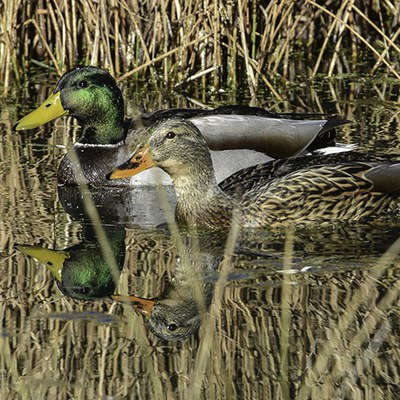
These are the quintessential duck, taking the rank as the most abundant duck in the world. The mallard is the ancestor to most domesticated breeds of ducks and can be found in nearly every town in North America.
Males and females have distinct differences in their plumage displays; males having a glossy green head, white ring on neck, brown chest, black rear, and yellow bill, and females have a more muted plumage display of mottled brown with an orangish brown bill. Both sexes have a vibrant blue stripe or “speculum” on their wings. Other than coloration, males’ and females’ size and appearance is very similar; approximately two feet in length, two to three pounds, and having flat wide bills.
Mallards are known as dabbling ducks—they feed underwater by tipping forward and grazing. What makes these ducks so prevalent is their adaptability to almost any wetland environment and their wide range of preferred food sources. Mallards are omnivores and will eat seeds, stems, roots, insects, mollusks, tadpoles, frogs, earthworms, small fish, etc.
Mallards are generally monogamous, pairing up in the fall or courting all winter until laying eggs in the spring. Fun fact: Mallards actually molt and become virtually flightless for three to four weeks during breeding season! Females will lay seven to 10 eggs (sometimes up to 15) on dry land next to the water, and incubate them for 26 to 30 days. Upon hatching, the young are immediately led to water and will remain there for roughly two months until they are able to fly.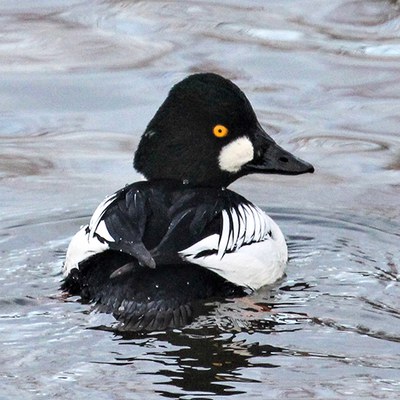
The common goldeneye is called so (quite obviously) because of its strikingly amber eye that is accentuated by its glistening green-black (male) or brown head (female). This medium-sized duck is a bit smaller than a mallard at approximately 18 inches in length and weighing one to two pounds. From an aerial perspective, adult males are all black with a black head and back, but nearly all white on the sides with a notable white circle on their cheeks. Adult females have an entirely brown head with grayish brown body plumage. Fun fact: The eyes of the common goldeneye change drastically over its adolescence, from dark purple to blue to greenish blue to pale green, then finally to bright amber yellow when they reach adulthood.
Common goldeneye are not dabbling feeders like mallards, but prefer instead to dive to forage for food, consisting mostly of crustaceans, mollusks, fish, worms, frogs, insects, and leeches. Goldeneye prefer a mostly carnivorous diet, but will eat some plant material when other food sources are not available.
Females usually lay between eight to 11 eggs in borrowed nests (made and used by other ducks) or tree cavities, and incubate the eggs for roughly one month. Hatchlings leave their tree nest after just one day and often have to make a leap down to the ground of up to 40 feet! The mother then takes the ducklings immediately to water where they can forage for food on their own and only require protection.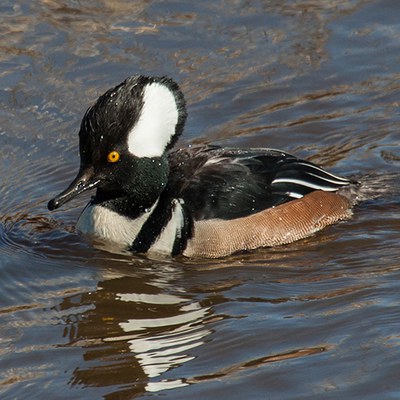
Think mohawk or windblown or Bride of Frankenstein, and you may be able to picture the great crest of feathers atop the hooded merganser’s head. Hooded merganser crests or hoods are fan-shaped and collapsible feathers that can stand up straight or lay flat on their head. They are small ducks with thin bills, approximately 18 inches in length and weighing just over one pound. Much like the goldeneye, male mergansers are black and white with a vibrant yellow eye, and females are a more muted gray and brown.
Hooded mergansers are divers, not dabblers, and prefer to catch aquatic insects, crayfish, and small fish. Fun fact: These ducks are incredibly good subaqueous hunters because they can actually change the refractive properties of their eyes to see better underwater and they have an extra transparent eyelid which helps protect their eyes.
Mergansers, like their goldeneye kin, lay their eggs in tree cavities or borrowed nests, usually having average clutches of 10 to 13 eggs, and incubate for 26 to 41 days. Also like goldeneyes, merganser ducklings must take a leap of faith from their high up nests in their first days of life to travel to water.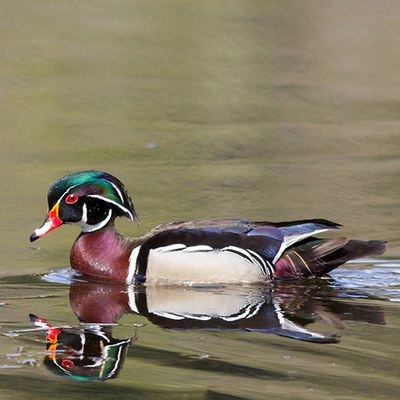
Wood ducks are one of the most strikingly beautiful ducks in the waterfowl family. The males have unmatched iridescent shimmering greens, purples, and pinks decorating their crested heads, backs, and wings. The rest of their bodies vary in ornate patterning; their sides look like a sepia tone topography map, while their breast is the color of a mottled chestnut shell, and their wing speculum a polished sapphire. The females, while less colorful, sport an elegant gray silver head with a white accent around their eyes, their breasts like granite, and a bright shimmer of color pokes out from their wing bands. Wood ducks are one of few species whose strong claws can grip bark, allowing them to perch in trees. They are similar in size to a hooded merganser.
The preferred meal for the truly omnivorous wood duck is mostly seeds, with some aquatic plants and insects. In many parts of the country, wood ducks rely on acorns as a major source of their diet. These ducks typically dabble and only do shallow diving.
Wood ducks are also cavity nesters and they love areas that are thickly wooded or highly vegetative (like large cattail marshes and beaver ponds). Wood ducks can be spotted at Camp Polk Meadow Preserve in the cattails. Their small stature and short, broad wings make them highly maneuverable in these areas. These ducks lay nine to 14 eggs and often will lay eggs in other mother’s nests, sometimes called “dump nests,” where there is no incubation. These are some of the only ducks that will have two broods of ducklings a year (more common in southern North America than northern).
Fun fact: The wood duck hen’s vocabulary includes an impressive array of “un-duck” like sounds. Most notably, instead of a quack, the female emits a loud “oo-eek, oo-eek” that is often used when uncomfortable. 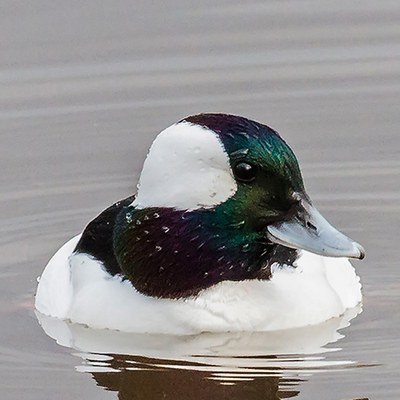
This is our smallest and most energetic diving duck with some major flare to boot. The male bufflehead’s oversized head glimmers green and purple iridescent with the appearance of a large pie slice removed, leaving a white patch on the back of its head. The rest of its body is a sleek and stark torpedo of black on white. The female is an unassuming brown and gray duck with a large head and distinctive white cheek patch. Both sexes measure around one foot in length and weigh between one half and just-over one pound.
Buffleheads are impressive divers and use their skills to catch aquatic invertebrates, insects, and mollusks as a main food source. Dives for food typically last between 12 and 25 seconds.
These small ducks choose woodpecker and Northern flicker holes as their nesting cavities, often preferring cavities found in aspen and poplars. Bufflehead are another mostly monogamous species and will stay with their partner for a few years, laying one brood of four to 17 eggs per year. Males will often leave the females during incubation in order to molt, but will return to help protect the ducklings.
Fun fact: “Bufflehead fossils from the late Pleistocene (about 500,000 years ago) have been found in Alaska, California, Florida, Illinois, Kansas, Texas, and Washington. One California fossil that resembles a modern Bufflehead dates to the late Pliocene, two million years ago” (Cornell).
Sources:
Learn more:
- Join the Land Trust on an upcoming bird walk at one of our Community Preserves!
- Cool Words for Hot Times: Indicator Species
- The Lone Hummingbird
 About Megan Kellner-Rode
About Megan Kellner-Rode
Megan is an Oregonian through and through, enjoying all things pine-scented and grown in Oregon soil. She graduated from the University of Oregon with a degree in Journalism. She spent time on farms both urban and rural, worked the ins and outs of local food nonprofits, wrote for local food publications, has been a board member at Bend Farmers Market, High Desert Food & Farm Alliance, and Central Oregon Locavore, and is the organizer of the Central Oregon Fill Your Pantry event. Above all, Megan loves having her hands in the dirt, cooking, and being with her loved ones.


